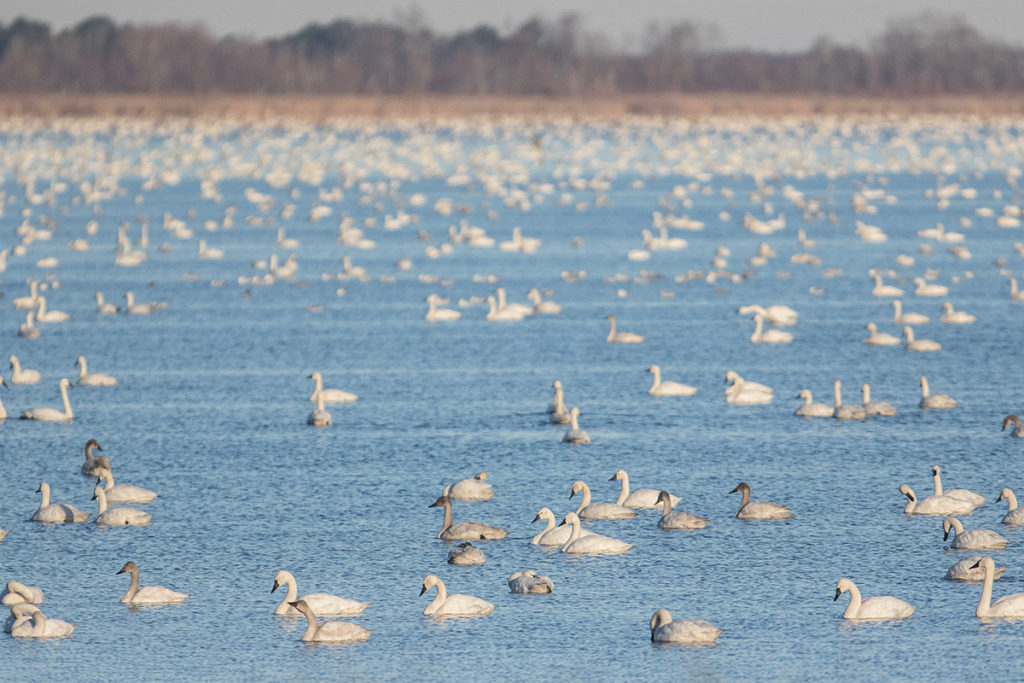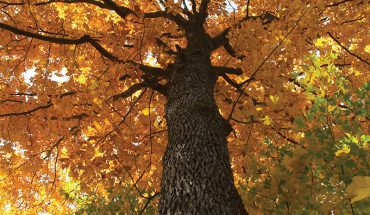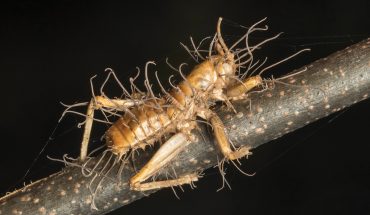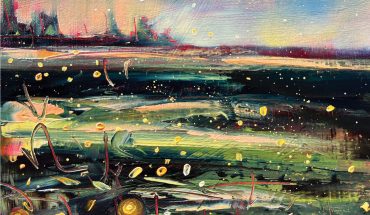Each winter, thousands of tundra swans migrate to eastern North Carolina, where they spend time preening, resting, and eating.
Words and photographs by Mike Dunn
The season of the swans is a magical time. In November, thousands of Tundra Swans arrive in northeastern North Carolina, where they’ll stay through February. Year after year, I find myself drawn to spend time in their elegant presence.
Tundra Swans occur in two population groups according to their migratory flyways: a large eastern one that the United States Fish and Wildlife Service estimates at around 117,000 and a smaller western one of about 56,000. Most of the eastern flyway swans breed in arctic wetlands, then migrate more than 3,000 miles to spend the winter along the East Coast.
An estimated 70% to 80% of those overwinter in North Carolina, making the refuges, lakes, sounds and fields of the eastern part of our state a critical habitat for Tundra Swans. Some of the best places to observe our wintering swans are Pea Island, Lake Mattamuskeet and Pocosin Lakes National Wildlife Refuges, and on Lake Phelps at Pettigrew State Park.
Over my decades of observing Tundra Swans, I have enjoyed many special moments. Most of them start at dawn, when the birds are still in their overnight roosting spots in open water safe from most predators. After daybreak they will fly out periodically to feed.
The swans’ diet has primarily been aquatic vegetation in our sounds and large coastal lakes, but they now feed extensively on waste grain and winter wheat in agricultural fields due to declines in natural vegetation.
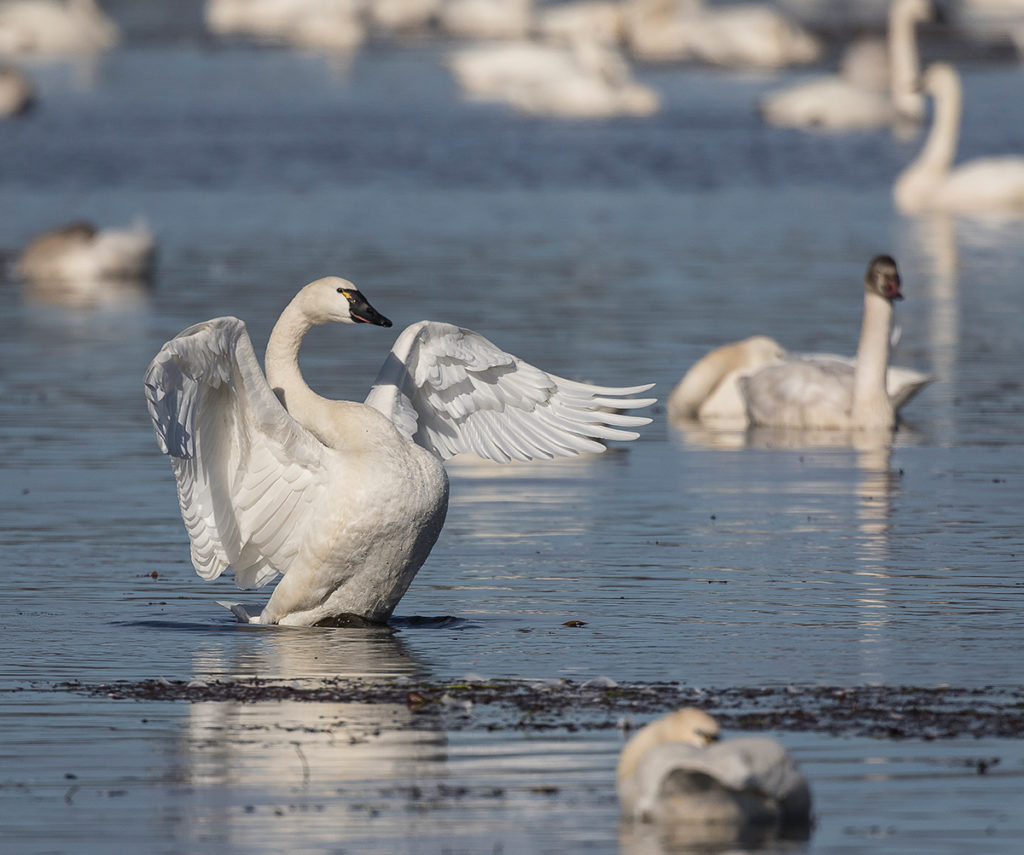
When not feeding, swans spend a lot of time napping. They also spend a lot of time preening: Each Tundra Swan has about 25,000 feathers, compared to 14,000 for a Northern Pintail duck or 7,000 for a Bald Eagle (and the American Robin has only around 3,000 feathers!).
This self-care and relaxation are occasionally interrupted by squabbles between adjacent groups of swans over things that only they understand. These aggressive bouts usually involve outstretched necks with trumpeting calls, wing quivers and, if all that bluster fails, actual physical contact like aggressive biting and flailing of their impressive wings.
Following an encounter, group members often engage in more wing-quivering and calling, the so-called “triumph ceremony.” (This is oddly similar to human behavior when family members reunite — we all know those gatherings can sometimes have their moments.)
Afterward, there is often a “wing flap” by one or more of the group members. It’s a striking behavior: The bird rises up and flaps three or four times, exposing amazing sculptural details in its huge wings. Every winter, I spend way too much time trying to photograph the perfect wing flap.
For several winters, my museum educator workshops assisted biologists with swan capture and banding on the Pungo Unit of Pocosin Lakes National Wildlife Refuge as part of a study on migratory movements. We’d use corn to draw the birds to bait stations at the edge of the water, then capture them by firing a net.
Staff would rush in and hand birds out from under the net to volunteers, who each then took their bird to a processing station to weigh it, determine its sex and put a leg band put on. Then the volunteer would walk their swan to the lake edge and release it.
These birds are hard to handle: Each weighs 15 to 20 pounds, with a wing span of up to 6 feet and a powerful kick. The trick was to get control of its wings and hold them with their feet pointing away from you. Once that was done, the birds would calm down, and sometimes they would lay their heads on the volunteer’s shoulder while waiting to be processed.
(I joked that if just one swan were to tell the others to “go for their eyes,” the whole study would have been hopeless.) But holding and releasing one of these majestic birds, knowing I was helping learn more about its critical habitat areas, is something I’ll never forget.
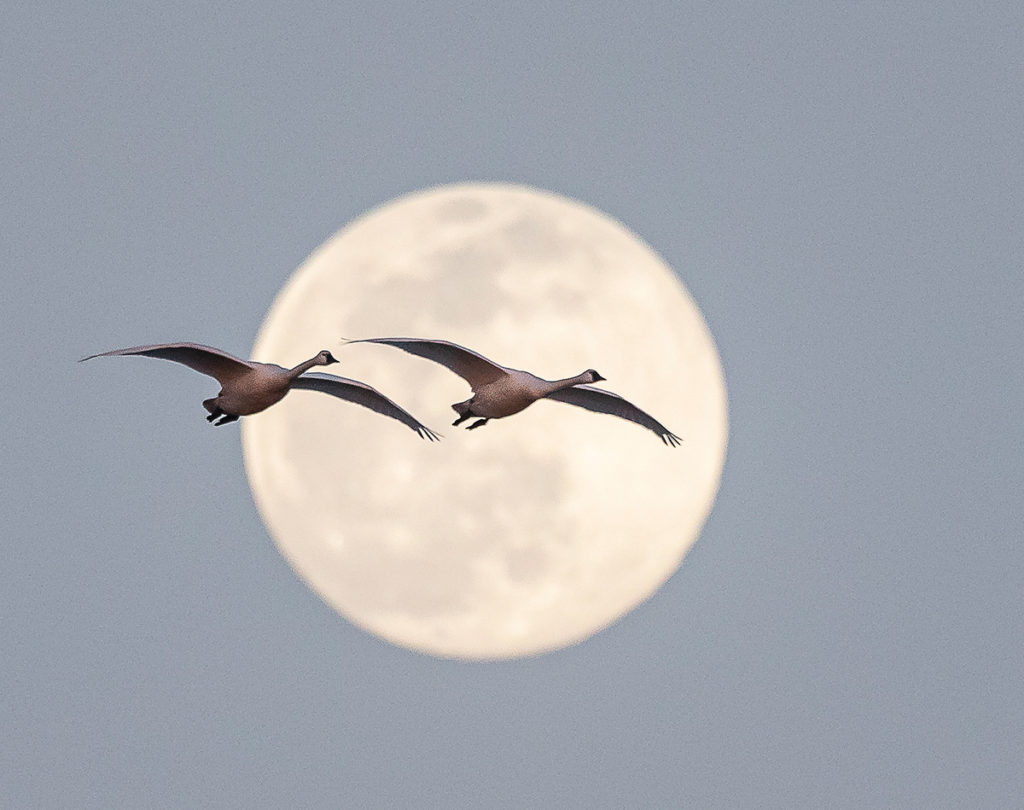
One of the best things about being with the swans is the sounds they add to the landscape. Their main call is a soft ou, ou, reminiscent of the baying of hounds in the distance. Other sounds include a mellow hoot, with an occasional squeak or whistle thrown in.
You can hear the whirring of the wind through their wing feathers when they fly low overhead. And if you are reasonably close, you can hear the slapping noises made by their huge webbed feet as they run across the water to take off.
These sounds played a special role in another fond memory. While birding at Lake Mattamuskeet one winter, a car pulled up. A teacher I know got out and asked if we had found any good birds. She and her friend, who stayed in the vehicle, were hoping to see some of the winter waterfowl in the area. I invited the group to follow me over to the Pungo Unit, where they had never been, to see what we could find. When we arrived, we could see and hear thousands of Tundra Swans and Snow Geese flying to and from Pungo Lake, landing in the fields to feed.
We could see the birds from the car, but wanted to get closer. As we got out and started to move, I noticed that one person was using a wheelchair. I was briefly surprised, but my soon-to-be new friend, Rick Mashburn, was quite self-sufficient. The usually muddy road at the edge of the field was frozen, and Rick navigated his wheelchair down the path toward the feeding flocks without incident.
Everyone was in awe. In addition to the sights and sounds of swirls of white birds, we saw Bald Eagles, and then two bears walking through the field. We all knew we had witnessed something special, something magical.
A few days later, Rick sent me an email thanking me for that opportunity. Every winter after that, he contacted me to check on what was happening with the birds on the refuge before making his own trip down with friends to witness the spectacle. Then came a very special email in 2006: Rick sent me tickets to a premiere of an orchestra piece that his partner had written. It was music inspired by a trip to Pungo and the sights and sounds of the birds.
The piece was entitled The Swans of Pungo Lake. I had no idea that Rick’s partner, Kenneth Frazelle, is a composer. Ken had been commissioned, along with a few other North Carolina composers, to create musical “postcards” about the state as part of the 75th anniversary season of the North Carolina Symphony. Ken chose the wilds of Pungo and the birds that winter there as his topic.
The piece starts and ends with the peaceful mood of a winter scene in a vast landscape and speeds up in the middle, capturing the imagery of swirling flocks of birds and the sounds of thousands of pairs of wings beating in the cold air. It was such a privilege to attend the premiere.
I saw Rick several times at these wildlife refuges over the years, always enjoying his conversations and obvious love of birds. Sadly, as I was writing this piece, I learned of Rick’s passing this past May. His obituary mentions his trips to Pungo and his belief in the wondrous perfection of birds.
I couldn’t agree more. To watch and listen to Tundra Swans is a privilege. It always reconnects me to the grandeur of nature and reminds me that there are things more beautiful, wonderful and important than anything you see on a screen or hear in the news.
Now, when I am in the presence of the Tundra Swans, I think about the importance of sharing these moments with others. And I remember my friend Rick.
This article originally appeared in the January 2023 issue of WALTER magazine.

